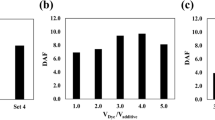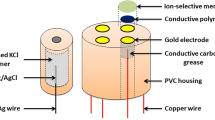Abstract
Measurements of pH are important in industry, agriculture, medicine, etc. Two main principles, namely electrochemical and optical ones, have been employed in pH meters and sensors. This paper is aimed at the development of extrinsic fiber-optic sensors of saliva pH. Such sensors have already been used for monitoring pH changes caused by biological processes. In this paper, fiber-optic sensors consisted of inlet and outlet silica fibers transmitting light from a halogen lamp to a sample cell and then to a diode-array spectrometer. Two types of sample cells were used; namely a silica cell with a measurement path of 10 mm, and a special silica capillary cell with a hole diameter of 0.07 mm and measurement path up to 40 mm. This capillary, produced at the Institute, consists of a Bragg mirror applied onto the inner silica capillary wall. Both the sensors were calibrated by using Sorensen buffers with bromothymol blue and a commercial pH meter. The calibration curves were used for the determination of pH of saliva samples collected from one healthy person at different times. It has been found that the fiber-optic sensors provide us with lower pH values than the pH meter. This result can be explain by effects of saliva components on bromothymol blue spectra. By using a correlation line between pH values measured by the sensors and those from the pH meter the sensor reliability of about 0.3 pH units can be estimated.






Similar content being viewed by others
References
Khan MI, Mukherjee K, Shoukat R, Dong H (2017) A review on pH sensitive materials for sensors and detection methods. Microsyst Technol 23:4391–4404
Seifter JL, Chang H-Y (2017) Extracellular acid-base balance and ion transport between body fluid compartments. Physiology 32:367–379
Johnsson F, Joelsson B (1988) Reproducibility of ambulatory oesophageal pH monitoring. Gut 29:886–889
Kirubakaran C, Gnananayagam JEJ, Sundaravalli EK (2003) Comparison of blood gas values in arterial and venous blood. Indian J Pediatr 70:781–785
Farnaud SJC, Kosti O, Getting SJ, Renshaw D (2010) Saliva: physiology and diagnostic potential in health and disease. Sci World J 10:434–456
Saibaba G, Srinivasan M, Aarthy AP, Silambarasan V, Archunan G (2017) Ultrastructural and physico-chemical characterization of saliva during menstrual cycle in perspective of ovulation in human. Drug Discov Ther 11:91–97
Edgar VM (1992) Saliva: its secretion, composition and functions. Br Dent J 172:305–312
Sujatha S, Jalihal U, Devi Y, Rakesh N, Chauhan P, Sharma S (2016) Oral pH in gastroesophageal reflux disease. Indian J Gastroenterol 35:186–189
Rolfe P (2012) Micro- and nanosensors for medical and biological measurement. Sens Mater 24:275–302
Zuliani C, Matzeu G, Diamond D (2014) A potentiometric disposable sensor strip for measuring pH in saliva. Electrochim Acta 132:292–296
Fudali-Walczak M, Raba G, Obłoza B (2015) Saliva pH testing in predicting dental caries in children aged 7–10 years. Prz Med Uniw Rzesz Inst Leków 13:90–94
Shrestha A, Tahir R, Kishen A (2007) Optical sensor based system to monitor caries activity. In: Popp J, von Bally G (eds) Biophotonics 2007: optics in life science, vol 6633. Proceedings of SPIE-OSA biomedical optics (Optical Society of America, 2007), paper 6633_42
Kishen A, John MS, Lim CS, Asundi A (2003) A fiber optic biosensor (FOBS) to monitor mutans Streptococci in human saliva. Biosens Bioelectron 18:1371–1378
Luo C, Wang Y, Li X, Jiang X, Gao P, Sun K, Zhou J, Zhang Z, Jiang Q (2017) An optical sensor with polyaniline-gold hybrid nanostructures for monitoring pH in saliva. Nanomaterials 7:67–78
Matejec V, Kasik I, Podrazky O, Aubrecht J, Frank M, Jelinek M, Kubecek V (2013) Preparation and characterization of Bragg fibers with air cores for transfer of laser radiation. In: Kalli K, Kanka J, Mendez A (eds) Micro-structured and specialty optical fibres II. Proc. SPIE vol. 8775 (SPIE, Bellingham, WA, 2013) Article 877508
Buffer calculator, Programmed by Dr. Rob Beynon. University of Liverpool, UK. http://www.biomol.net/en/tools/buffercalculator.htm. Accessed 17 Dec 2018
Stasio N, Shibukawa A, Papadopoulos IN, Farahi S, Simandoux O, Huignard J-P, Bossy EJ, Moser C, Psaltis D (2015) Towards new applications using capillary waveguides. Biomed Opt Express 6:4619–4631
Keller BK, DeGrandpre MD, Palmer CP (2007) Waveguiding properties of fiber-optic capillaries for chemical sensing applications. Sens Actuators B Chem 125:360–371
Qu H, Skorobogatiy M (2012) Resonant bio- and chemical sensors using low-refractive-index-contrast liquid-core Bragg fibers. Sens Actuators B Chem 161:261–268
Qu H, Ung B, Roze M, Skorobogatiy M (2012) All photonic bandgap fiber spectroscopic system for detection of refractive index changes in aqueous analytes. Sens Actuators B Chem 161:235–243
Matejec V, Kasik I, Podrazky O, Barton I (2015) Bragg fibers for absorption-based sensing. Conf Pap Sci. https://doi.org/10.1155/2015/954539
Osório JH, Marques THR, Figueredo IC, Serrão VA, Franco MAR, Cordeiro CMB (2017) Optical sensing with antiresonant capillary fibers. In Proc. SPIE 10323, 25th international conference on optical fiber sensors, Article 103233U (23 April 2017). https://doi.org/10.1117/12.2265350
Boron WF, Boulpaep EL (2012) Medical physiology: a cellular and molecular approach. Elsevier, Amsterdam
Martan T, Aubrecht J, Podrazky O, Matejec V, Kasik I (2014) Detection of hydrocarbons using suspended core microstructured optical fiber. Sens Actuators B Chem 202:123–128
Acknowledgements
This work was financially supported by the Czech Science Foundation (contract 16-10019S).
Author information
Authors and Affiliations
Corresponding author
Ethics declarations
Conflict of interest
The authors declare that there is no conflict of interest.
Electronic supplementary material
Below is the link to the electronic supplementary material.
Rights and permissions
About this article
Cite this article
Matějec, V., Barton, I., Pospisilova, M. et al. Extrinsic Fiber-Optic Sensor for Detection of Saliva pH. Chemistry Africa 2, 301–307 (2019). https://doi.org/10.1007/s42250-019-00050-5
Received:
Accepted:
Published:
Issue Date:
DOI: https://doi.org/10.1007/s42250-019-00050-5




